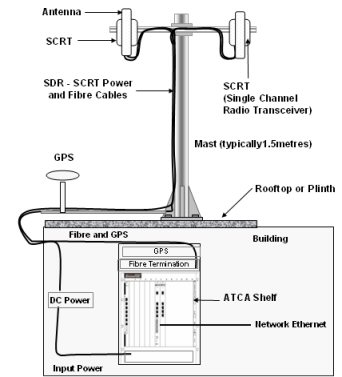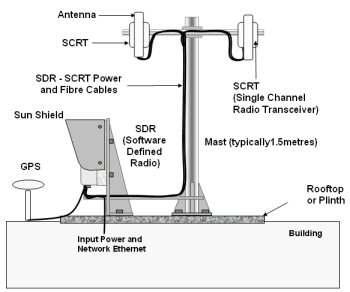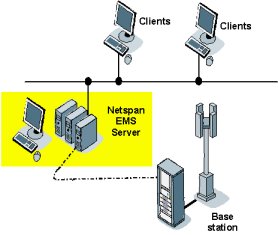
The Airspan HiperMAX Base Station product range forms part of a family of ASMAX WiMAX products.
HiperMAX is a base station product designed to support both fixed and mobile WiMAX (256 OFDM and OFDMA) system profiles. It is capable of fixed and nomadic applications when running 802.16-2004 256 OFDM (Fixed WiMAX) and, additionally portable and mobile applications when running OFDMA (Mobile WiMAX). HiperMAX is optimised for maximum system link budget, capacity and spectrum efficiency through smart antenna techniques to allow aggressive system wide frequency re-use.
The flexibility of the HiperMAX architecture allows many deployment configurations including those suited to both macro and micro cellular installations. It supports all outdoor (non-weather protected) as well as split indoor / outdoor configurations allowing the operator to select the deployment model best suited to operational expense considerations and site access constraints.
HiperMAX is a modular base station which is made up of various common elements to produce system configurations suitable for any deployment scenario. The basic system elements are as follows:
Software Defined Radio (SDR): This is the heart of the system. It is basically a very large array of digital signal processors running software to create / decode a baseband WiMAX composite digital signal. The SDR is available as both indoor equipment (HiperMAX) and outdoor equipment (HiperMAX-micro).
Mast-head Transceiver Assembly: A masthead mounted assembly which up / down converts from baseband to RF.
Fibre Interconnect: The SDR and masthead transceiver are connected via an optical fibre interconnect in accordance with the OBSAI standard.
The masthead transceiver assemblies and fibre interconnects are generally common to all HiperMAX configurations.
Note:This product overview covers some features that may be available through future software upgrades. This overview may be changed and some features removed without notice. Exact availability of individual features should be confirmed through your sales representative.
The HiperMAX base station is optimised for traditional multi-sector macro-cell deployments consisting of a baseband section, suitable for location within a protected environment, and an outdoor RF section. The system will therefore operate from existing macro-cell sites, used in traditional cellular deployments. The indoor SDR boards, referred to as blades within the ATCA standard, are housed in an ATCA chassis. The outdoor enclosure contains the RF subsystem components, which enables smart antenna functionality running on a Software Defined Radio (SDR).
HiperMAX is designed to implement a 1, 2, 3 or 4 channel element array for a variety of supported frequency bands. HiperMAX Base stations will also support Adaptive Antenna System (AAS) and Multiple In, Mutiple Out (MIMO) for OFDMA operation. MIMO operation, running over the HiperMAX antenna array is expected to enhance capacity by two or three times and improve frequency re-use, compared with traditional methods.
The connection between the indoor and outdoor equipment is achieved through a fibre-optical cable and separate power feed

Typical HiperMAX installation with roof top antenna
The all outdoor version of HiperMAX is known as HiperMAX-micro. This consists of split baseband and RF sections connected via a fibre interface, but with all power supply and synchronisation functionality housed within a single SDR-micro enclosure. This form factor is particularly well suited to low density micro-cell sites where access to a temperature controlled room is not possible or preferred. eg. A building rooftop.

Typical HiperMAX-micro installation
The Airspan WiMAX compliant platform supports three management options:
Local web based client management of individual system components
Used to configure small systems and networks
Management via third party SNMP management tool
Uses standard WiMAX MIB
Netspan network management server
Already running numerous BWA networks worldwide
Based on Microsoft.net platform
Distributed server architecture support
Full system configuration, operation and maintenance via standard web client
SNMP API support
Uses standard WiMAX MIB for all configuration and O&M activities

Netspan Client /Server Architecture
Server: Supports an SQL database for configuration & alarm storage with an option for 3rd party access direct to database via SNMP.
Client: Accessed via Internet Explorer or other compatible browser software and connects to the server via IP.